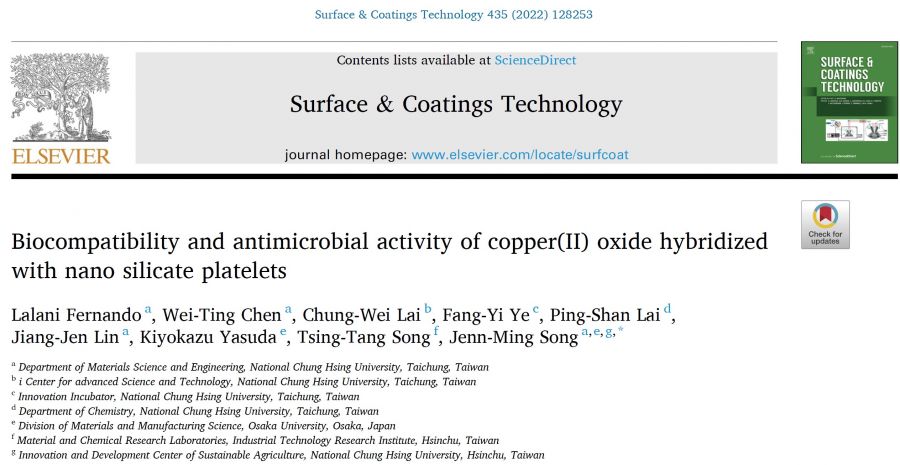設施農業:綠能設施開發【材料科學與工程學系宋振銘教授】
| 論文篇名 | 英文:Biocompatibility and antimicrobial activity of copper(II) oxide hybridized with nano silicate platelets 中文: 複合CuO之奈米矽片之生物可容性與抗菌活性 |
| 期刊名稱 | SURFACE & COATINGS TECHNOLOGY |
| 發表年份,卷數,起迄頁數 | 2022, 28, 101620 |
| 作者 | Fernando, Lalani; Chen, Wei-Ting; Lai, Chung-Wei; Ye, Fang-Yi; Lai, Ping-Shan; Lin, Jiang-Jen; Yasuda, Kiyokazu; Song, Tsing-Tang; Song, Jenn-Ming(宋振銘)* |
| DOI | 10.1016/j.surfcoat.2022.128253 |
| 中文摘要 | 奈米CuO為受矚目之抗菌材料,但對細胞的毒害限制了其用途。本研究將針狀奈米CuO披覆於厚度約1 nm之奈米二氧化矽片(稱之奈米矽片)表面,實驗結果顯示奈米矽片可有效避免CuO團聚,且該奈米複合材料能有效殺菌且具細胞生物親和性。於最佳條件可消滅金黃色葡萄球菌達99%、大腸桿菌達88%。電子自旋共振結果顯示,CuO/NSP產生•OH自由基,能有效破壞細胞成分,從而導致細菌死亡。 |
| 英文摘要 | Nano-sized copper(II) oxide (CuO) is an interesting material with proficient antibacterial activities but limited due to its toxicity to mammalian cells. In this study, CuO nano-sized needles were coated on the surface of nano-silicate platelets (NSP), which were exfoliated from natural montmorillonite clays and with the thickness of about 1 nm, to form nanohybrids. Our findings indicate that NSPs can effectively prevent the aggregation of CuO needles, and significantly enhance antibacterial efficiency without affecting biocompatibility. An optimal antibacterial activity against Staphylococcus aureus exceeding 99% could be obtained, while that for Escherichia coli was about 88%. Electron paramagnetic resonance results suggest that •OH radicals, one of the reactive oxygen species generated by CuO/NSP, might damage the cellular components and thus result in the death of bacterial. |
| 發表成果與本中心研究主題相關性 | 農業相關殺菌、抗病毒應用 |







